Tax Loss Opportunities in Emerging Market Portfolios


After a phenomenal 2017, the last eight months have been painful for emerging market (EM) investors. The initial leg lower coincided with a general spike in volatility in February. Since then, we’ve seen declines from January levels of almost 15% for a broad EM equity index, 20% for broad China benchmarks, 13% for EM local currency debt and close to 4% for EM hard currency debt. A large portion of this was driven by EM currencies, which were down more than 8% over this time period. However, despite this period of negative performance, we believe this year’s downdraft could lead to opportunity.
EM Assets: 1/31/18—9/30/18
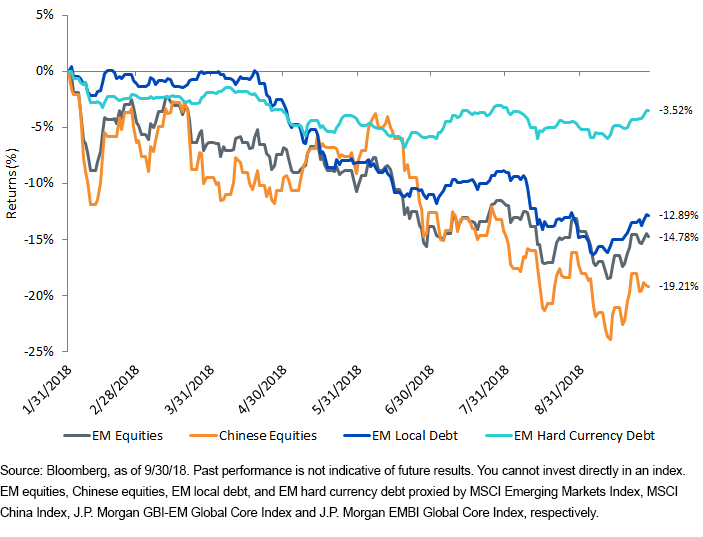
For definitions of terms in the chart, please visit our glossary.
Taking Stock of EM
When assets are down by these magnitudes, it provides investors an important opportunity to evaluate the exposures in their portfolios and look for opportunities to refresh positions while booking tax losses that may offset realized gains elsewhere in the portfolio.
We examined the top 10 largest active and passive mutual funds/exchange-traded funds (ETFs) in EM equities, Chinese equities, EM local debt and EM hard currency debt and evaluated their performance during the downturn in order to highlight opportunities for tax loss harvesting.
Global EM Equities
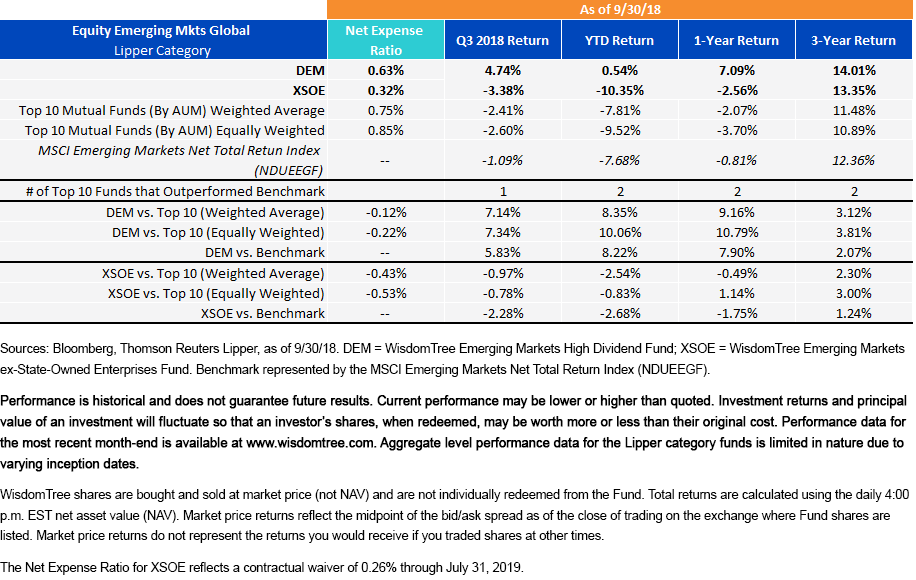
For standardized performance of the Funds, please see their respective ticker: DEM, XSOE.
Opportunities in Emerging Market Equities: Whether one has been allocating to core and broad-based passive ETFs or using an active manager, this has been a tough year for EM equity positions. There are a few options to consider when swapping EM equities.
- Emerging Markets Value: DEM, our high-dividend fund, has over a 10-year history of outperforming the MSCI Emerging Markets Index; it has one of the lowest valuations of strategies we have, with aggregate price-to-earnings ratios less than 10x earnings. As of September 30, 2018, this has a correlation with the broad MSCI Emerging Markets Index over the last three years of 0.92 and has been outperforming in 2018 due to being under-weight in the Technology sector and over-weight in the Energy and Materials sectors.
- Emerging Markets Growth Oriented: XSOE, our ex-state-owned enterprises ETF, is positioned as a unique factor strategy that tilts to consumer- and technology-oriented companies, which generally have been showing strong underlying growth trends over the last few years. XSOE has very high tracking to the general market indexes with 0.98 correlation over the last three years but 100 basis points (bps) of annualized outperformance.
Chinese Equities
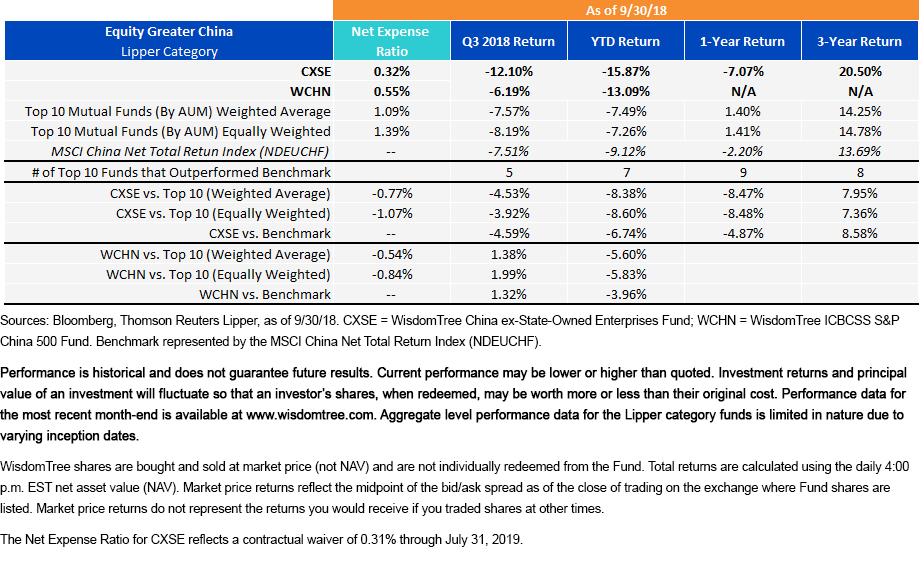
For standardized performance of the Funds, please see their respective ticker: CXSE, WCHN.
Opportunities in China: Clearly, the Trump administration has taken a very hard-line stance on China, and how these negotiations will play out is tough to say. We believe ultimately some type of deal will be made, similar to the new USMCA (aka, the revised NAFTA). If one has losses in China exposures, we like the long-run merits of the China ex-state owned enterprises theme. At 32 bps, CXSE is approximately half the expense ratio of the largest ETFs in the category while giving a unique lens into the longer-run consumer and technology themes of the newer economy sectors in China.
For broad China access, WCHN is an all-inclusive Fund we see for accessing all share classes of Chinese equities, with 50% of its weight in A-shares. While the Consumer Discretionary sector has underperformed Energy by a large margin over the past year, we continue to believe that our approaches to beta in China could represent a more intuitive approach for accessing the future engine of Chinese growth.
EM Local Debt
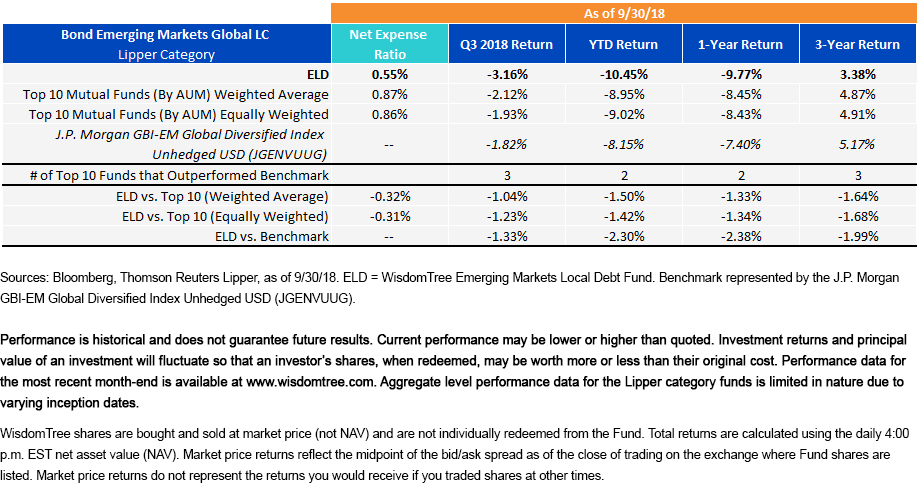
Opportunities in Emerging Market Local Debt: We tend to think of complementing EM equities with EM debt as a way to lower volatility, but over last eight months, the equity and debt declines have been almost identical because of currency weakness. This is a category where all-in yields have also picked up, so many conversations we’ve had recently are about wanting to maintain exposure to the asset class while picking up the tax loss trade.
EM Hard Currency Debt
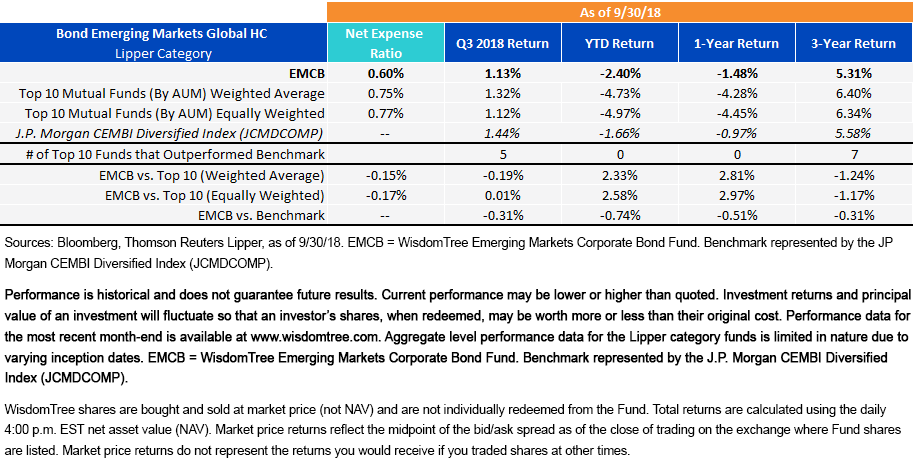
For standardized performance of EMCB, please click here.
Opportunities in Emerging Market Hard Currency Debt: While EM currency weakness has accounted for a majority of the losses in EM local debt, rising U.S. interest rates and widening credit spreads have served as a headwind for EM fixed income denominated in U.S. dollars. In our view, we’re currently more constructive on corporate debt compared with sovereign debt. Additionally, EM corporate debt tends to have less interest rate risk than EM sovereigns. Therefore, if you’re concerned about rising rates in your bond portfolio, EM corporates could be an attractive way to manage volatility across EM while diversifying away from traditional U.S. corporate credit risk.
Conclusion
The U.S. dollar, after being weaker against pretty much every EM currency in 2017, has been considerably stronger in 2018. The Federal Reserve has continued to hike rates so that some of the “carry spreads” for emerging markets started to look less attractive, resulting in a tightening of financial conditions. Investors are questioning if there are risks of contagion like those we saw in the late ’90s.
In short, the market is thinking of all the things that could potentially go wrong for emerging markets versus what could go right. While the near term will undoubtedly be subject to volatility, we believe the current downdraft could present an opportunity for long-term allocators to refresh valuation and improve the tax profile of their portfolio while at the same time maintaining a high correlation with traditional benchmarks.
All data is sourced from Bloomberg as of September 30, 2018, unless otherwise stated.
Important Risks Related to this Article
Neither WisdomTree Investments, Inc., nor its affiliates, nor Foreside Fund Services, LLC, or its affiliates provide tax advice. All references to tax matters or information provided on this site are for illustrative purposes only and should not be considered tax advice and cannot be used for the purpose of avoiding tax penalties. Investors seeking tax advice should consult an independent tax advisor.
There are risks associated with investing, including possible loss of principal. Foreign investing involves special risks, such as risk of loss from currency fluctuation or political or economic uncertainty. Some of these Funds focus their investments in China, including A-shares, which include risk of the RQFII regime and Stock Connect program, thereby increasing the impact of events and developments associated with the region, which can adversely affect performance. Investments in emerging or offshore markets are generally less liquid and less efficient than investments in developed markets and are subject to additional risks, such as risks of adverse governmental regulation and intervention or political developments. The Funds’ exposure to certain sectors may increase their vulnerability to any single economic or regulatory development related to such sector. As these Funds can have a high concentration in some issuers, the Funds can be adversely impacted by changes affecting those issuers. These Funds will be required to include cash as part of their redemption proceeds, which introduces additional risks, particularly due to the potential volatility in the Chinese market and market closures. The Funds invest in the securities included in, or representative of, their Indexes regardless of their investment merit, and the Funds do not attempt to outperform their Indexes or take defensive positions in declining markets. Due to the investment strategy of these Funds, they may make higher capital gain distributions than other ETFs. Please read each Fund’s prospectus for specific details regarding the Fund’s risk profile.

Jeremy Schwartz has served as our Global Chief Investment Officer since November 2021 and leads WisdomTree’s investment strategy team in the construction of WisdomTree’s equity Indexes, quantitative active strategies and multi-asset Model Portfolios. Jeremy joined WisdomTree in May 2005 as a Senior Analyst, adding Deputy Director of Research to his responsibilities in February 2007. He served as Director of Research from October 2008 to October 2018 and as Global Head of Research from November 2018 to November 2021. Before joining WisdomTree, he was a head research assistant for Professor Jeremy Siegel and, in 2022, became his co-author on the sixth edition of the book Stocks for the Long Run. Jeremy is also co-author of the Financial Analysts Journal paper “What Happened to the Original Stocks in the S&P 500?” He received his B.S. in economics from The Wharton School of the University of Pennsylvania and hosts the Wharton Business Radio program Behind the Markets on SiriusXM 132. Jeremy is a member of the CFA Society of Philadelphia.

